 Triangle Congruence
Triangle Congruence
Roughly, two geometric figures are congruent when they have exactly the same size and shape. Two geometric figures that are congruent can be superimposed, one on the other, so that they coincide exactly.
For example, two figures drawn on a piece of paper are congruent if they can be cut out and matched up perfectly (where flipping the paper over is allowed).
The symbol used for congruence is ‘$\,\cong \,$’.
For example, the sentence ‘$\,\Delta ABC\cong \Delta DEF\ $’ is read as ‘triangle $\,ABC\,$ is congruent to triangle $\,DEF\ $’.
CPCTC
When reporting congruences, you must do so in a way that ‘matches up’ corresponding parts.
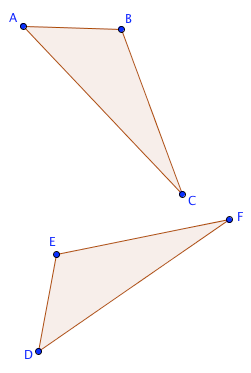
For example, when you report that $\,\Delta ABC\cong \Delta DEF\,,$ then all of the following are true:
- $\,m\angle A=m\angle D\,$
- $\,m\angle B=m\angle E\,$
- $\,m\angle C=m\angle F\,$
- $\,AB=DE\,$ (recall that $\,AB\,$ represents the distance from $\,A\,$ to $\,B\,$)
- $\,AC=DF\,$
- $\,BC=EF\,$
This property will be referred to as ‘CPCTC’:
Corresponding Parts of Congruent Triangles are Congruent
In this congruence, vertex $\,A\,$ corresponds to vertex $\,D\,.$ Vertex $\,B\,$ corresponds to vertex $\,E\,.$ Vertex $\,C\,$ corresponds to vertex $\,F\,.$
The congruence can be reported in any way that preserves this correspondence between the vertices. For example, here are two other correct ways that the congruence could be reported:
$\,\Delta BAC\cong \Delta EDF\,$
or
$\,\Delta CBA\cong \Delta FED\,$
However, $\,\Delta BAC\cong \Delta DEF\,$ is not a correct way to report the congruence indicated above.
Determining that Two Triangles are Congruent
When two triangles are congruent, then there is a correspondence such that all three angles have equal measures, and all three sides have equal lengths.
Thus, when two triangles are congruent, there are six ‘natural’ pieces of equal information. However, to determine that two triangles are congruent, you certainly don't have to specify all six pieces of information!
So—how many, and what types, of information need to be specified to determine that two triangles are congruent?
Is it enough to say that two sides are the same? Clearly not, as the sketch below shows:
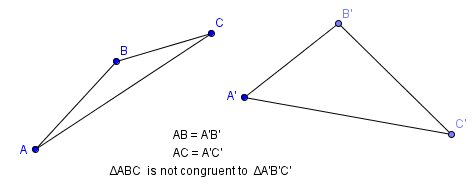
Is it enough to say that two angles are the same? Well, two angles the same requires all three angles to be the same; is this enough to guarantee congruence? Clearly not, as the sketch below shows:
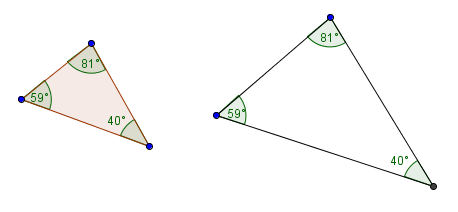
Triangles with the same angles are said to be similar triangles; one of the triangles is just a ‘scaled version’ of the other. However, similar triangles do not need to be congruent, because they can be different sizes. Similar triangles have the same shape, but not necessarily the same size.
Suppose two triangles do indeed have the same angles. If we additionally specify that one (corresponding) side must be the same, then this determines the size of the triangle, and forces them to be congruent.
You can specify the side between two known angles, which is called an included side. This is called ASA (angle-side-angle) congruence. Notice that the ‘S’ is in the middle, indicating that the side is between the two angles.
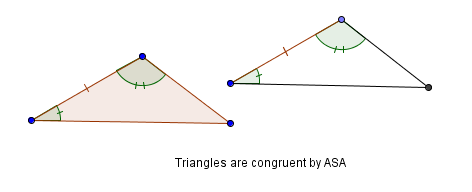
Or, you can specify a side that is not between two known angles, which is called a non-included side. This is known as AAS (angle-angle-side) congruence. Notice that the ‘S’ is not between the two ‘A’s, indicating that the side is not between the two angles.
This type of congruence can alternatively be called SAA congruence.
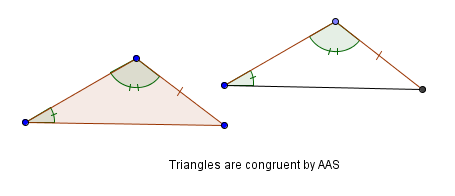
Triangle Congruence Theorems: ASA, AAS, SAS, SSS
The precise statements are given below:
A unique triangle is formed by two angles and the included side.
Therefore, if two angles and the included side of one triangle are congruent to two angles and the included side of another triangle, then the triangles are congruent.
A unique triangle is formed by two angles and a non-included side.
Therefore, if two angles and the side opposite one of them in a triangle are congruent to the corresponding parts in another triangle, then the triangles are congruent.
Next, imagine taking two boards, which can be of different lengths, and attaching them with a hinge at one end. The hinge can be used to open and close the two boards.
Notice the unique triangle that is formed in this way! That is, two sides and an included angle uniquely determine a triangle, leading to the SAS congruence theorem:
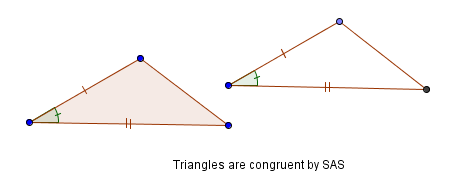
A unique triangle is formed by two sides and the included angle.
Therefore, if two sides and the included angle of one triangle are congruent to two sides and the included angle of another triangle, then the triangles are congruent.
Finally, imagine taking the same two boards you had before, with the hinge between them. This time, however, you have a third board, which you want to attach to the un-hinged ends.
If the third board isn't too long or too short, then you'll be able to open the hinge just the right amount to attach the third board and form a unique triangle! This motivation leads to the ‘SSS’ congruence theorem:
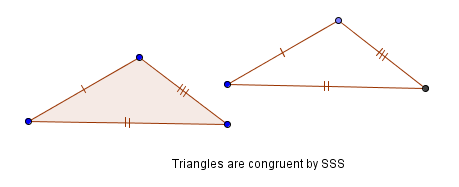
A unique triangle is formed by specifying three sides of a triangle, where the longest side (if there is one) is less than the sum of the two shorter sides.
Therefore, if three sides of a triangle are congruent to three sides of another triangle, then the triangles are congruent.
One final comment. Imagine a triangle with vertices $\,A\,,$ $\,B\,,$ and $\,C\,.$ (Draw a picture and use it as you read through this discussion.)
Imagine that you are at $\,A\,,$ want to travel to $\,C\,,$ and can only travel along the sides of the triangle. There are two routes you can take:
- you can go directly from $\,A\,$ to $\,C\,$
- you can go from $\,A\,$ to $\,B\,,$ and then from $\,B\,$ to $\,C\,$
Clearly, the first path must be shorter, since the shortest distance between two points is a straight line!
This discussion leads to an important property of triangles:
The following is also true: if three numbers satisfy the property that the sum of any two of them exceeds the third, then there exists a triangle with these lengths for its sides.
So, does there exist a triangle with sides of lengths $\,2\,,$ $\,3\,,$ and $\,6\,$? No, since $\,2+3\,$ is not greater than $\,6\,.$ Use this image: Take a board of length $\,6\,$ (this is the longest side) and lay it down on a table. Attach boards of lengths $\,2\,$ and $\,3\,$ at each end. They're just flapping about in the breeze—they're not long enough to touch each other!
Does there exist a triangle with sides of lengths $\,2\,,$ $\,3\,,$ and $\,4\,$? Yes, since $\,2+3\gt 4\,,$ $\,3+4\gt 2\,,$ and $\,4+2\gt 3\,.$ Again, you can use this image: Take a board of length $\,4\,$ (this is the longest side) and lay it down on a table. Attach boards of lengths $\,2\,$ and $\,3\,$ at each end. They can be adjusted to form a unique triangle.
Concept Practice
This is an optional introductory paragraph.